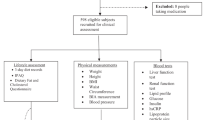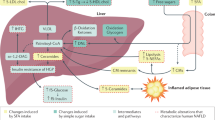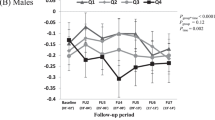Abstract
Objective:
A high monounsaturated fatty acid (MUFA) and polyunsaturated fatty acid (PUFA) intake is associated with lower plasma low-density lipoprotein (LDL)-cholesterol. However, PUFA may increase the susceptibility of LDL to undergo oxidative modifications. The aim of this study was to analyze the association of habitual dietary fat intake with LDL size and oxidizability.
Design:
Cross-sectional.
Setting:
Cohort study.
Subjects:
Seven hundred and fifty-eight subjects with normal, impaired glucose metabolism and type II diabetes.
Interventions:
Mean LDL size was measured by high-performance gel-filtration chromatography. In vitro oxidizability of LDL was determined by measuring lag time, reflecting the resistance of LDL to copper-induced oxidation. Information about dietary fat intake was obtained by a validated food frequency questionnaire.
Results:
PUFA intake (energy percent) was significantly and negatively associated with LDL size in subjects with type II diabetes (standardized beta (95% confidence interval) −0.17 (−0.28;−0.06)) and impaired glucose metabolism – although not statistically significant – (−0.09 (−0.24;0.05)), but not in subjects with normal glucose metabolism (0.01 (−0.10;0.12)) (P-value for interaction=0.02). No significant associations were observed for total, saturated fat and MUFA intake with LDL size. Intake of fat was associated with lag time; however, the small magnitude of the associations suggested that the composition of dietary fat is not a major factor affecting lag time. The same association with lag time was observed in all three glucose metabolism categories.
Conclusions:
In individuals with abnormal glucose metabolism, higher PUFA intake is associated with smaller LDL particle size, but does not alter the susceptibility of LDL to in vitro oxidation.
Sponsorship:
Dutch Diabetes Research Foundation, and the Nederlandse Organisatie voor Wetenschappelijk Onderzoek (NWO).
This is a preview of subscription content, access via your institution
Access options
Subscribe to this journal
Receive 12 print issues and online access
$259.00 per year
only $21.58 per issue
Buy this article
- Purchase on Springer Link
- Instant access to full article PDF
Prices may be subject to local taxes which are calculated during checkout
Similar content being viewed by others
References
Abbey M, Belling GB, Noakes M, Hirata F, Nestel PJ (1993). Oxidation of low-density lipoproteins: intraindividual variability and the effect of dietary linoleate supplementation. Am J Clin Nutr 57, 391–398.
Alberti KG, Zimmet PZ (1998). Definition, diagnosis and classification of diabetes mellitus and its complications. Part 1: diagnosis and classification of diabetes mellitus. Provisional report of a WHO consultation. Diabet Med 15, 539–553.
Austin MA, Rodriguez BL, McKnight B, McNeely MJ, Edwards KL, Curb JD et al. (2000). Low-density lipoprotein particle size, triglycerides, and high-density lipoprotein cholesterol as risk factors for coronary heart disease in older Japanese-American men. Am J Cardiol 86, 412–416.
Braam LA, Ocke MC, Bueno-de-Mesquita HB, Seidell JC (1998). Determinants of obesity-related underreporting of energy intake. Am J Epidemiol 147, 1081–1086.
Campos H, Dreon DM, Krauss RM (1995). Associations of hepatic and lipoprotein lipase activities with changes in dietary composition and low density lipoprotein subclasses. J Lipid Res 36, 462–472.
Chait A, Brazg RL, Tribble DL, Krauss RM (1993). Susceptibility of small, dense, low-density lipoproteins to oxidative modification in subjects with the atherogenic lipoprotein phenotype, pattern B. Am J Med 94, 350–356.
de Graaf J, Hak-Lemmers HL, Hectors MP, Demacker PN, Hendriks JC, Stalenhoef AF (1991). Enhanced susceptibility to in vitro oxidation of the dense low density lipoprotein subfraction in healthy subjects. Arterioscler Thromb 11, 298–306.
de Vegt F, Dekker JM, Ruhe HG, Stehouwer CD, Nijpels G, Bouter LM et al. (1999). Hyperglycaemia is associated with all-cause and cardiovascular mortality in the Hoorn population: the Hoorn study. Diabetologia 42, 926–931.
de Vegt F, Dekker JM, Jager A, Hienkens E, Kostense PJ, Stehouwer CD et al. (2001). Relation of impaired fasting and postload glucose with incident type II diabetes in a Dutch population: the Hoorn study. JAMA 285, 2109–2113.
Dejager S, Bruckert E, Chapman MJ (1993). Dense low density lipoprotein subspecies with diminished oxidative resistance predominate in combined hyperlipidemia. J Lipid Res 34, 295–308.
Dreon DM, Fernstrom HA, Williams PT, Krauss RM (1999). A very low-fat diet is not associated with improved lipoprotein profiles in men with a predominance of large, low-density lipoproteins. Am J Clin Nutr 69, 411–418.
Dreon DM, Fernstrom HA, Campos H, Blanche P, Williams PT, Krauss RM (1998). Change in dietary saturated fat intake is correlated with change in mass of large low-density-lipoprotein particles in men. Am J Clin Nutr 67, 828–836.
Esterbauer H, Striegl G, Puhl H, Rotheneder M (1989). Continuous monitoring of in vitro oxidation of human low density lipoprotein. Free Radical Res Commun 6, 67–75.
Gardner CD, Fortmann SP, Krauss RM (1996). Association of small low-density lipoprotein particles with the incidence of coronary artery disease in men and women. JAMA 276, 875–881.
Heine RJ, Dekker JM (2002). Beyond postprandial hyperglycaemia: metabolic factors associated with cardiovascular disease. Diabetologia 45, 461–475.
Hulshof KFAM, Ocké MC, van Rossum CTM, Buurma-Rethans EJM, Brants HAM, Drijvers JJMM et al. (2004). Resultaten van de voedselconsumptiepeiling 2003. RIVM rapport 350030002/2004. TNO rapport no. V6000. RIVM, Bilthoven.
Kannel WB, McGee DL (1979). Diabetes and cardiovascular risk factors: the Framingham study. Circulation 59, 8–13.
Kleinveld HA, Hak-Lemmers HL, Stalenhoef AF, Demacker PN (1992). Improved measurement of low-density-lipoprotein susceptibility to copper-induced oxidation: application of a short procedure for isolating low-density lipoprotein. Clin Chem 38, 2066–2072.
Kratz M, Gulbahce E, von Eckardstein A, Cullen P, Cignarella A, Assmann G et al. (2002). Dietary mono- and polyunsaturated fatty acids similarly affect LDL size in healthy men and women. J Nutr 132, 715–718.
Kratz M, Cullen P, Kannenberg F, Kassner A, Fobker M, Abuja PM et al. (2002). Effects of dietary fatty acids on the composition and oxidizability of low-density lipoprotein. Eur J Clin Nutr 56, 72–81.
Lamarche B, Tchernof A, Moorjani S, Cantin B, Dagenais GR, Lupien PJ et al. (1997). Small, dense low-density lipoprotein particles as a predictor of the risk of ischemic heart disease in men. Prospective results from the Quebec Cardiovascular Study. Circulation 95, 69–75.
Mooy JM, Grootenhuis PA, de Vries H, Valkenburg HA, Bouter LM, Kostense PJ et al. (1995). Prevalence and determinants of glucose intolerance in a Dutch caucasian population. The Hoorn study. Diabetes Care 18, 1270–1273.
Ocke MC, Bueno-de-Mesquita HB, Pols MA, Smit HA, van Staveren WA, Kromhout D (1997a). The Dutch EPIC food frequency questionnaire. II. Relative validity and reproducibility for nutrients. Int J Epidemiol 26 (Suppl 1), S49–S58.
Ocke MC, Bueno-de-Mesquita HB, Goddijn HE, Jansen A, Pols MA, van Staveren WA et al. (1997b). The Dutch EPIC food frequency questionnaire. I. Description of the questionnaire, and relative validity and reproducibility for food groups. Int J Epidemiol 26 (Suppl 1), S37–S48.
Reaven P, Parthasarathy S, Grasse BJ, Miller E, Almazan F, Mattson FH et al. (1991). Feasibility of using an oleate-rich diet to reduce the susceptibility of low-density lipoprotein to oxidative modification in humans. Am J Clin Nutr 54, 701–706.
Regnstrom J, Nilsson J, Tornvall P, Landou C, Hamsten A (1992). Susceptibility to low-density lipoprotein oxidation and coronary atherosclerosis in man. Lancet 339, 1183–1186.
Rivellese AA, Maffettone A, Vessby B, Uusitupa M, Hermansen K, Berglund L et al. (2003). Effects of dietary saturated, monounsaturated and n-3 fatty acids on fasting lipoproteins, LDL size and post-prandial lipid metabolism in healthy subjects. Atherosclerosis 167, 149–158.
Schaefer EJ (2002). Lipoproteins, nutrition, and heart disease. Am J Clin Nutr 75, 191–212.
Schatzkin A, Kipnis V, Carroll RJ, Midthune D, Subar AF, Bingham S et al. (2003). A comparison of a food frequency questionnaire with a 24-hour recall for use in an epidemiological cohort study: results from the biomarker-based Observing Protein and Energy Nutrition (OPEN) study. Int J Epidemiol 32, 1054–1062.
Scheffer PG, Bakker SJ, Popp-Snijders C, Heine RJ, Schutgens RB, Teerlink T (2001). Composition of LDL as determinant of its susceptibility to in vitro oxidation in patients with well-controlled type 2 diabetes. Diabetes Metab Res Rev 17, 459–466.
Scheffer PG, Bakker SJ, Heine RJ, Teerlink T (1997). Measurement of low-density lipoprotein particle size by high-performance gel-filtration chromatography. Clin Chem 43, 1904–1912.
Scheffer PG, Bos G, Volwater HG, Dekker JM, Heine RJ, Teerlink T (2003). Associations of LDL size with in vitro oxidizability and plasma levels of in vivo oxidized LDL in Type 2 diabetic patients. Diabet Med 20, 563–567.
Shikany JM, White Jr GL (2000). Dietary guidelines for chronic disease prevention. South Med J 93, 1138–1151.
Siri PW, Krauss RM (2005). Influence of dietary carbohydrate and fat on LDL and HDL particle distributions. Curr Atheroscler Rep 7, 455–459.
Spijkerman AM, Adriaanse MC, Dekker JM, Nijpels G, Stehouwer CD, Bouter LM et al. (2002). Diabetic patients detected by population-based stepwise screening already have a diabetic cardiovascular risk profile. Diabetes Care 25, 1784–1789.
Steinberg D, Parthasarathy S, Carew TE, Khoo JC, Witztum JL (1989). Beyond cholesterol. Modifications of low-density lipoprotein that increase its atherogenicity. N Engl J Med 320, 915–924.
Stichting NEVO (1996). NEVO tabel. Nederlands Voedingsstoffenbestand 1996. (NEVO table. Dutch nutrient database 1996). Voorlichtingsbureau voor de Voeding, Den Haag (in Dutch).
Vega GL, Groszek E, Wolf R, Grundy SM (1982). Influence of polyunsaturated fats on composition of plasma lipoproteins and apolipoproteins. J Lipid Res 23, 811–822.
Yoshino G, Hirano T, Kazumi T (2002). Atherogenic lipoproteins and diabetes mellitus. J Diabetes Complications 16, 29–34.
Yu-Poth S, Etherton TD, Reddy CC, Pearson TA, Reed R, Zhao G et al. (2000). Lowering dietary saturated fat and total fat reduces the oxidative susceptibility of LDL in healthy men and women. J Nutr 130, 2228–2237.
Acknowledgements
We thank the research assistants of the Diabetes Onderzoeks Centrum in Hoorn for their cooperation with this study. We also thank Bert Volwater for technical assistance. The project was funded by the Dutch Diabetes Research Foundation (Grant No. DFN 98901) and the Dutch Organization for Scientific Research, NWO (Grant No. 940-35-034).
Author information
Authors and Affiliations
Corresponding author
Rights and permissions
About this article
Cite this article
Bos, G., Poortvliet, M., Scheffer, P. et al. Dietary polyunsaturated fat intake is associated with low-density lipoprotein size, but not with susceptibility to oxidation in subjects with impaired glucose metabolism and type II diabetes: the Hoorn study. Eur J Clin Nutr 61, 205–211 (2007). https://doi.org/10.1038/sj.ejcn.1602492
Received:
Revised:
Accepted:
Published:
Issue Date:
DOI: https://doi.org/10.1038/sj.ejcn.1602492
Keywords
This article is cited by
-
Circulating linoleic acid and alpha-linolenic acid and glucose metabolism: the Hoorn Study
European Journal of Nutrition (2017)



